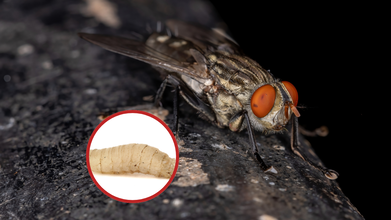- Health Conditions A-Z
- Health & Wellness
- Nutrition
- Fitness
- Health News
- Ayurveda
- Videos
- Medicine A-Z
- Parenting
- Web Stories
Israeli Scientists Created The First Lab-Grown Kidney That Survived 34 Weeks

Researchers at Tel Aviv University and Sheba Medical Center have made a major scientific breakthrough by successfully growing a human kidney organoid in the laboratory. An organoid is a tiny, three-dimensional model of an organ, and this new creation is far superior to any previous model. For the first time, the team grew the kidney organoid from specialized kidney stem cells, rather than from more general stem cells. This innovative approach has resulted in a model that perfectly mirrors the development of a human fetal kidney.
One of the most remarkable aspects of this new organoid is its longevity. It can be kept alive and stable for an impressive 34 weeks, which is more than six months. This marks a significant improvement over older models, which typically failed and broke down after only four weeks. This extended lifespan allows for long-term research and medical testing on the kidney model.
Also Read: Flesh-Eating Screwworm Parasite Detected in First US Human Case: Know the Warning Signs
How Did Scientists Make This Lab-Grown Kidney?
Before this breakthrough, scientists used "master" cells called pluripotent stem cells to grow organoids. The problem was that these cells could turn into any type of cell, which often led to the organoids being "contaminated" with unwanted cells from other parts of the body. This made experiments difficult to trust.
The new method is different. It uses stem cells that are already programmed to only become kidney cells. Because of this, the new organoid is a "clean" model, made purely of kidney tissue. This purity allows for more accurate and reliable experiments, so scientists can be sure their results are directly related to the kidney.
This new model gives researchers a clear look at how a kidney grows. They can watch for months as different parts of the kidney form, like the blood filters and urinary ducts. By using this model, they made a big discovery about birth defects. They intentionally blocked a signal in the organoid and watched as a developmental problem appeared, one that is known to cause kidney birth defects in people. This shows them exactly how a small mistake in development can lead to a serious medical condition.
How Does The Artificial Kidney Change Medicine
Researchers explain that this breakthrough provides a powerful new tool that could change medicine.
Understanding Disease
The model helps scientists see how problems in development lead to kidney diseases. This could lead to new treatments that fix the root cause of these illnesses.
Safe Drug Testing
Researchers can now safely test if new drugs are harmful to a developing kidney, which is especially important for protecting babies during pregnancy.
Regenerative Medicine
This new process creates a reliable supply of kidney cells. These cells could be used in research or as building blocks for new therapies to repair or replace damaged kidneys.
Why Is This Artificial Kidney So Important?
Although the organ made is not yet transplantable, it is a step towards better care and more organ transplants for people who need it. To understand how the wait time increases or decreases, a 2025 study published in JAMA Open Network, used a computer model of 662,190 patients found that if the kidney transplant waiting list grew, so would the wait times.
- A 10% increase in the waiting list would add about 4 months to the wait time.
- A 50% increase in the waiting list would add about 20 months to the wait time.
As the time increases, so does the desperation for a properly working organ that helps them increase the quality of their life. This artificial kidney could help many people, who are in the waitlist, by helping them sustain for more than 6 months, while they wait for a new organ for the transplant. Researchers are working towards bettering this medical future, which will soon be helping many.
Most Heart Attacks Strike Between 7-11am, Cardiologist Explains What Puts Your Mornings At Risk

(Credit-Canva)
We all want to have a relaxed and easy. Rushing to get ready, eating unhealthy breakfasts and running out the door, these habits are not feasible and can be difficult to maintain. Although getting up early and getting things in order before you leave may seem like a lot of work, it can be the best option not only for your mental health, but also your heart.
According to cardiologist Dr. Sanjay Bhojraj, a board-certified cardiologist, your morning routine can significantly impact your heart health. He warns that the hours after you wake up are a "high-alert window" for your heart, as this is when the body's natural processes can increase the risk of a heart attack.
However, it is not just his professional opinion, studies have shown that there is a time period, i.e. 7 am – 11 am, when we are most susceptible to heart attacks and you may be surprised to know how many people suffer sudden cardiac events within these hours.
How Are Morning Hours Dangerous For Heart Events?
According to a 2020 study published in the Trends in Cardiovascular Medicine journal, for many years, research supported the idea that sudden cardiac arrests followed a predictable pattern.
Morning Peak: Several studies from the late 1980s and early 1990s found that sudden cardiac death was most common in the morning, typically between 7 a.m. and 11 a.m.
Weekly Peak: Some studies also showed a "Monday peak," where more events occurred on Mondays than on any other day of the week. This was often linked to the stress of starting the work week.
Seasonal Peak: There was also evidence of a seasonal pattern, with more events happening in the winter months.
This pattern was thought to be due to natural daily changes in the body, such as fluctuations in heart rate, blood pressure, and stress hormones like cortisol.
Does This Time Pattern Still Affect Heart Events?
More recent studies are starting to tell a different story. Research from the past decade, including a large study called the Oregon Sudden Unexpected Death Study, has found no clear morning or Monday peak for sudden cardiac arrests. While many studies still show a low number of events in the early morning hours (between 12 a.m. and 6 a.m.), the classic morning peak has disappeared. This has been attributed to:
Better Medication
The widespread use of medications like beta-blockers has been shown to reduce the effects of stress hormones that were thought to cause the morning peak.
Improved Treatment
Advances in treating heart failure and coronary artery disease have also changed the way cardiac arrests present.
Modern Lifestyle
Our 24/7 lifestyle with constant access to technology and stress may have spread the risk factors for cardiac arrest more evenly throughout the day and week, eliminating the "Monday peak."

Why Do Mornings Stress Out Our Heart?
Dr Bhojraj explains that when you first wake up, your body goes through several changes that can be stressful for your heart. These include:
- Your body experiences a surge in cortisol, which is the stress hormone, in the morning to help you wake up, but it can also put a strain on your cardiovascular system.
- Your blood platelets, which help with clotting, become stickier. This can increase the risk of blood clots that may block arteries.
- Your also blood pressure increases as part of the waking process.
How To Start Your Day In A Heart Healthy Way
To protect your heart, Dr. Bhojraj suggests a gentle morning routine rather than a frantic one. He advises against rushing into the day with high-stress activities. Here are his recommendations for a heart-healthy morning:
Drink water as soon as you wake up.
Taking your medications on time is especially important for any heart-related prescriptions.
Eat a protein-rich breakfast like to start your day.
Take 10 to 15 minutes for some gentle exercise before you get busy.
Starting your day slowly because it can help reduce the stress on your heart and set a positive tone for the rest of your day.
Flesh-Eating Screwworm Parasite Detected in First US Human Case: Know the Warning Signs

(Credit-Canva)
The first ever human case of this flesh-eating parasite infestation has been detected in the US. The Department of Health and Human Services (HHS) reported that the case of infestation by the New World screwworm (NWS) parasite was confirmed on August 4, involves a patient who had recently traveled back to the US from El Salvador.
What is the New World Screwworm or Flesh-Eating Parasite?
The New World screwworm myiasis is a parasitic infection caused by the larvae, or maggots, of a parasitic fly. These maggots are known for feeding on the living flesh of their hosts and are drawn to open wounds, where they lay their eggs. While they primarily infest livestock like cattle, they can also affect pets, wildlife, and, in rare instances, even people. Health officials, including the Centers for Disease Control and Prevention (CDC), have stated that the risk to the general public in the US remains very low.
This devastating pest is usually found in parts of South America and the Caribbean. Despite efforts to stop its spread, the parasite has moved northward, with cases now confirmed in every Central American country, including Mexico.
What Is The First Symptoms of Flesh-Eating Screwworm In Humans?
The CDC explains that the NWS infestations are extremely painful. The most obvious sign is seeing maggots in or around an open wound, or even in your nose, eyes, or mouth. Other symptoms can include:
- Sores or wounds that don't heal or get worse over time.
- Painful wounds that may bleed.
- A foul smell coming from the wound.
- A crawling sensation as you feel the maggots moving inside the wound.
- Sometimes, a fever or chills can occur if a bacterial infection develops.
If you experience these symptoms after traveling to Central or South America or the Caribbean, it's important to tell your doctor about your recent trip.
Who is at Risk For Flesh-Eating Screwworm Parasite?
Your risk of getting an NWS infestation increases if you travel to areas where the flies are present and:
- You have an open wound, such as from a scratch, cut, insect bite, or recent surgery.
- You have a weakened immune system, perhaps from a medical condition like HIV, cancer treatment, or certain medications.
- You have a medical condition that causes open sores, like some skin or sinus cancers.
- You sleep outdoors.
- You live or work around livestock or other warm-blooded animals in these regions.
How Does Flesh Eating Parasite Spread?
An infestation starts when a female NWS fly lays her eggs in an open wound or body opening like the nose or mouth. The smell of a wound, even a small one like a tick bite, can attract the flies. A single female fly can lay 200–300 eggs at a time.
Once the eggs hatch, the tiny maggots burrow into the living tissue to feed. After they've fed, they drop to the ground, burrow into the soil, and eventually turn into adult flies, starting the cycle over again.
How Can You Prevent Flesh Eating Screwworm Infection?
If you see or feel maggots in a wound or on your body, you should contact a healthcare provider right away. They will need to remove the larvae, which sometimes requires surgery. It is very important that you do not try to remove the maggots yourself. Prevention is the best way to avoid an infestation.
- Keep any open wounds clean and covered.
- Wear long-sleeved shirts, pants, and socks to protect your skin from bites.
- Use an EPA-approved insect repellent.
- Treat your clothing and gear with products that contain 0.5% permethrin.
- Sleep indoors or in rooms with screens.
Meet Jessica Knurick, The Dietitian Taking On The 'MAHA' Movement

Credits: Instagram and jessicaknurick.com
Jessica Knurick is a registered dietitian with a PhD who has rapidly emerged as one of the most influential public health voices on social media. With more than 1.1 million followers on Instagram and over 335,000 on TikTok, she is using the same platforms that fueled misinformation to push back with evidence-based content. Her style is simple but powerful. She blends humor, accessible explanations, and scientific accuracy in short videos that debunk myths and highlight where health narratives go wrong.
Her journey into this digital advocacy space was personal. During her first pregnancy in 2019, she noticed scattered but not overwhelming amounts of misleading information targeted at expecting mothers. By the time she had her second child in 2022, the pandemic had amplified conspiratorial and fear-based health content across platforms. What had once been background noise became the dominant message being shown to her feeds. That was when she realized the scale of the problem, and the urgent need for credible counter voices.
Also Read: IV Drip, COVID-19 Shot And Ozempic: How Different Injections Enter The Body In Different Ways
Understanding the MAHA Movement
The Make America Healthy Again (MAHA) movement emerged out of a growing distrust in public health institutions. Initially fueled by wellness influencers and conspiracy-laced narratives about toxins, chemicals, and corrupt medical systems, the movement gained a national platform when Robert F. Kennedy Jr. launched his presidential campaign in 2024. Now serving as Secretary of Health and Human Services under Donald Trump, Kennedy and the MAHA agenda are reshaping health policy with their focus on distrust of regulation, vaccines, and science.
MAHA thrives because it taps into genuine frustrations. Rising chronic disease rates, expensive healthcare, and a food system often criticized for prioritizing profits over people’s well-being all resonate with Americans. But where the movement gains attention is in its framing, blaming shadowy corruption, demonizing ingredients like seed oils or food dyes, and questioning the legitimacy of mainstream health guidelines.
Read: What Is 'Make America Healthy Again' All About?
The results have been concerning. Falling vaccination rates, for example, contributed to a historic measles outbreak this year. Yet millions of Americans continue to be swayed by MAHA’s polished social media messaging and distrust of traditional experts.
Knurick’s Counter-Narrative Strategy
Knurick does not deny that the US has a chronic disease crisis. She acknowledges that too many people are living with conditions linked to lifestyle and systemic problems. What she challenges is how MAHA leaders explain those problems and the solutions they propose.
Her method is to meet people where they are, on Instagram and TikTok, and arm them with tools to navigate misinformation. In her videos, she often points out logical fallacies, like confusing correlation with causation. She also highlights overlooked factors that evidence shows drive chronic disease: income inequality, lack of access to healthcare, education gaps, and systemic disparities. These social determinants of health are almost entirely absent from MAHA’s messaging.
Knurick also calls out contradictions and financial interests within the MAHA leadership. Many of its most prominent figures run supplement companies or wellness product businesses, financially benefiting from the fear they spread. She argues that if the pharmaceutical and food industries deserve scrutiny for conflicts of interest, so too should the wellness industry, which operates with far less regulation.
Balancing Tone and Reach
One of Knurick’s challenges is tone. She knows that many MAHA supporters are parents, especially mothers, who are genuinely anxious about their children’s health.
These women are vulnerable to fear-based messaging like “Are you poisoning your kids?” which thrives in wellness circles. Being a mother herself, Knurick understands the emotional triggers at play.
Her approach is firm but not condescending. She avoids personal attacks on ordinary supporters, focusing instead on the misinformation itself. While her critiques of Kennedy are sharp, she maintains that her goal is not to mock but to explain. The result has been encouraging.
Many followers who initially came to her page as skeptics admit to being swayed by her evidence-backed explanations.
Also Read: Trump’s Surgeon General Pick Raises Eyebrows With Vaccine Comments And Wellness Claims
Still, she recognizes she will not reach everyone. Those deeply loyal to MAHA leadership may tune out. But Knurick’s growing following and steady stream of messages from people who have reconsidered their views suggest her efforts are making a difference.
Rebuilding Trust in Science
Knurick’s larger mission goes beyond countering individual claims. She is working to rebuild a culture of trust in evidence and science. In a world where traditional appeals to authority no longer carry weight, she believes teaching media literacy is essential. By showing people how to spot out-of-context data, manipulated graphs, or exaggerated claims, she hopes to empower her audience to become more discerning consumers of information.
Her efforts are not just about defending institutions but about reframing public health in a way that resonates.
She agrees with MAHA that the system often fails people. Where she differs is in how to fix it. Instead of scapegoating food dyes or dismissing vaccines, she emphasizes systemic reforms, improved access, and real policy solutions.
Why Knurick Matters Now
The battle over health information is no longer confined to medical journals or government press releases. It is happening on TikTok, Instagram, and in the hands of influencers.
By stepping into that arena, Knurick represents a new model for public health communication: expert-led, evidence-driven, but adapted to the realities of the digital age.
As misinformation continues to spread and movements like MAHA reshape national policy, her work is more critical than ever. She is not just correcting false claims but also offering a vision of what a more honest, evidence-based conversation about health could look like.
© 2024 Bennett, Coleman & Company Limited

